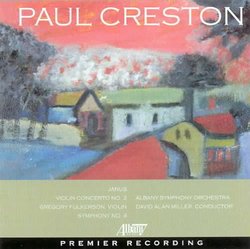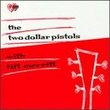CD Details
Synopsis
Album DescriptionRay Bono writes in his program notes: "Fiercely independent. Self Reliant. Self-disciplined. Such descriptions invariably surface in accounts of Paul Creston's life. More emphatic is the assertion that, excluding keyboard lessons, he was "entirely self-taught" in music. And, in fact, the short, affable Italian-American was in many ways a supremely self-made man, even down to his name. Born on October 10, 1906 in Manhattan to an impoverished couple from Sicily, he was christened Giuseppe Guttovergi (the family name would later be recast as Guttoveggio). In childhood he was also called Joseph but by 15 had been dubbed Cress by his friends, after Crespino, the role he played in a high-school staging of Goldoni's comedy, The Fan. Before long, he reworked this Cress into a fuller, solidly American-sounding name - and exit Giuseppe-Joseph-Guttovergi-Guttoveggio; enter Paul Creston. He started composing at the age of eight, soon after his parents, recognizing his musical ability, managed to get him a piano and a teacher. Within a few years, he was capable enough to substitute for the teacher when the man was ill - and canny enough to deem the man musically incompetent. He moved on to better piano teachers, took organ lessons too and plunged into a ferocious self-directed study of the works of Bach, Rameau, Scarlatti, Rimsky-Korsakov, Chopin, Debussy and Ravel. These masters of form, harmony and color, he would always maintain, were his true teachers; from them alone did he learn composing and orchestration. From the onset of the Great Depression, when he wasn't trying to sell insurance or real estate, Creston was accompanying singers as a Musicians Emergency Fund member - and pondering a career as a writer. Or a concert pianist. Or a composer. After a favorable response to a set of dances he wrote for solo piano in 1932, and to his incidental music for a theater piece - and encouraged by composer and concert organizer Henry Cowell, he sat down, took stock of his talents and decided to concentrate seriously on composition. His early modest pieces were successful enough to earn him a positive mention in Aaron Copland's 1936 article about "America's young men of merit" (although Copland grouped him with rising composers whose work tended to be "somewhat" abstract"). Larger works followed, and more attention. He received two successive Guggenheim fellowships. And his Symphony No. 1, debuting in 1941, won the New York Music Critics' Circle Award and later took first prize in an international competition in Paris. The three orchestral works on this disc - a symphony, a concerto and what amounts to a musical diptych - are from Creston's finest period. Never before recorded for commercial release, they exemplify his talent for uniting lyricism with propulsiveness to make a considerable emotional impact."
Similar CDs
| |
CD Reviews
Viva Americana! Some very effervescent takes on Creston's Su David A. Hollingsworth | Washington, DC USA | 11/02/2005 (5 out of 5 stars) "Thanks in part to Albany Records' ever-so-lasting enterprising initiatives, the music of Paul Creston is making something of a comeback. Victimized by the fashion/trendy oriented critics of the 1960s and beyond, more and more listeners of today are realizing the true value of Creston's work in American music. This album does a wonderful justice to his musical art with the playing by all involved that's quite immaculate, vital, sympathetic, and not at all unfeeling from start to finish.
Commissioned by the Association of Women's Committee for Symphony Orchestra, Janus (1959) demonstrates Creston at his most imaginative. The beautiful yet dramatic prelude is spellbinding for its enigmatic rhetoric that reminds me of Barber and Hanson but also, strangely perhaps, of Janis Ivanovs (Latvia's foremost composer of the Twentieth Century). There's something mysterious in the articulacy of the strings and oboe solo that penetrates the listener. The dance, however, brings out more of its Bernsteinian outgoingness and paganism, with the instrumentation that has plenty of verve and some exotic coloring. And it is that sense of coloring and keen imagination that forms the very appeal to Creston's Second Violin Concerto. Composed in 1960 and premiered by Sir Georg Solti and the Los Angeles Philharmonic that same year, the concerto is a delightful piece. Its first movement begins calmly, with its material that is arrestingly laid back and introspective. The ensuing development heats up though, permeated with bits of outbursts and a good deal of virtuosity. The violin writing is especially ear-catching and I admire the orchestral panache that accompanies it. The andante second movement is ear-catching also and I'm awed of how concentrated the writing is, particularly of the cadenza. The lustre in the writing remains strong throughout this movement and the finale, where I cannot find a single dull moment. The idiom of the concerto may not be contemporary or avant garde, but it's the piece that illuminates even the heaviest of moods.
Creston's Fourth Symphony (1951) is the earliest work recorded here and it's very invigorating throughout. The vitality of the piece remains strong particularly in its first movement that just springs up joyously from the start. The development keeps the spirit going and the close is as rambunctious as ever. But for me, the heart of the symphony are the middle movements. Have you ever heard such a beautiful movement as the second (andante pastorale)? There are plenty of slow movements that have such a spellbindingly exquisite effects: muted strings, woodwind and horn solos, etc. that has so much of that magic, flair, and elegance (think of Bax, Vaugh Williams, Rorem, Barber, or even Myaskovsky and Lyatoshynsky). But this one must be ranked as one of the best. The distinctiveness of the movement is of abundance here and I love the playfulness in the middle section before dying down to this mystifying, sun-rising, early morning yet brightening mood this music brings forth. I only wish (as I did in reviewing Rorem's symphonies under Naxos)what Creston did more with that wonderful musical material of his. But some compensations are paid in the scherzo, which is adorably flamboyant with its strings pizzicati and some tantalizing horn writing. The ostentatious finale doesn't disappoint either, if short of eliminating some of the redundancies in the development.
Much of the spotlight goes to the David Alan Miller, the Albany Symphony Orchestra, and Gregory Fulkerson as violin soloist. The orchestra's refinement may not be absolute, but the playing have plenty of spirit and commitment. Miller approaches the scores with the insightfulness and imagination that brings the works above the commonplace of early to mid modern American music; thus, demonstrating how uncommon and unique Creston music actually is, and with no over-selling and exaggeration on his part. Gregory Fulkerson brings with him the added introspection and substance in the concerto (his cadenzas are wrought and never shallow or pretentious) while the recording is vibrant in sound. With the presentation as admirable as it is here, this albums signifies Albany Records' tireless yet courageous continuation in its promotion of neglected masterworks, American and otherwise."
|


 Track Listings (3) - Disc #1
Track Listings (3) - Disc #1